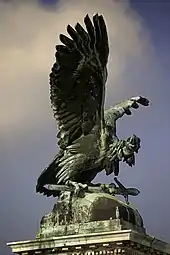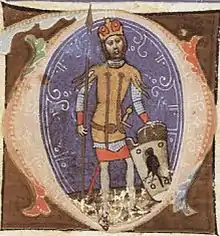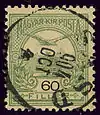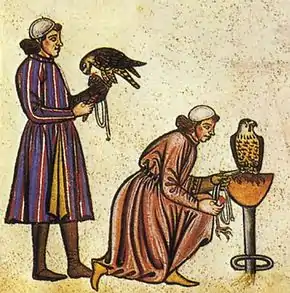Turul
The Turul is a mythological bird of prey, mostly depicted as a hawk or falcon, in Hungarian tradition and a national symbol of Hungarians.

Origin


The Turul is probably based on a large falcon, and the origin of the word is most likely Turkic (Clauson 1972: 472.[1]) (Róna-Tas et al. 2011:2: 954-56)[2]) 'toġrïl' or 'toğrul' means a medium to large bird of prey of the family Accipitridae, goshawk or red kite.[3] In Hungarian the word sólyom means falcon, and there are three ancient words describing different kinds of falcons: kerecsen [Greek κερχνηίς] (saker falcon), zongor [Turkish sungur = gyrfalcon] (which survives in the male name Csongor) and turul.
In Hungarian tradition, it presumably originated as the clan symbol used in the 9th and 10th centuries by the ruling House of Árpád.[4]
In the legend of Emese, recorded in the Gesta Hungarorum and the Chronicon Pictum, the turul is mentioned as occurring in a dream of Emese, when she was already pregnant.[5] In older literature, this was interpreted as "impregnation", but the text is clear.[6] The Turul's role is one of a protector spirit, that protects the little baby Álmos, from harm. In a second dream by the leader of the Hungarian tribes, in which eagles (the emblem of the Pechenegs) attacked their horses and a Turul came and saved them.
It is also said that the mythic bird, the Turul, is the original bird of the original Hungarians, the Magyars, who migrated out of the plains of Central Asia.[7] The legend says that in 896 AD, the bird dropped its sword in what is now modern day Budapest, indicating to the Magyars that the area was to be their homeland.[7] Thus, what they say was the beginning of the 1000 years the Magyars have lived in their now capital city area of Budapest.[7]
Modern use

The Turul is used as in the design of coats of arms of the Hungarian Defence Forces, the Counter Terrorism Centre and the Office of National Security.[8][9]
There were 3 large Turul statues, each with a wingspan of 15 metres, in Greater Hungary (before the country had its borders reconfigured by the Treaty of Trianon). The last of the three stands on a mountain near Tatabánya, Hungary, but the other two were destroyed. It is the largest bird statue in Europe, and the largest bronze statue in Central Europe.[10] There remain at least 195 Turul statues in Hungary, as well as 48 in Romania (32 in Transylvania and 16 in Partium), 8 in Slovakia, 7 in Serbia, 5 in Ukraine, 1 in Austria. One of the most recently erected, as of 29 September 2012, on St Michael the Archangel's Day, is in Hungary's Ópusztaszer National Heritage Park.[11]
Some of the Kingdom of Hungary postage stamps issued after 1900 feature the Turul.
In far-right politics
Throughout the 20th and 21st century, the Turul has been associated with a number of fascist and far-right ideologies. A particularly notable example of this is that of the Turul Association (Turul Szövetség). The association supported antisemitic policies such as the introduction of numerus nullus, a law which have banned Jewish students from studying at universities, and had close ties to the Arrow Cross Party.[12] The turul also remains a popular symbol in modern-day far-right politics.[13] As such, its use remains controversial, with many arguing that it is a symbol of hate and genocide, while others argue that its past uses ought to be ignored in favour of its historical significance.[14]
See also
References
- Clauson, Sir Gerard. 1972. An Etymological Dictionary of Pre-Thirteenth Century Turkish. Oxford: Clarendon Press.
- Róna-Tas, András, Árpád Berta, with the assistance of László Károly (eds). 2011. West Old Turkic, I-II. Wiesbaden: Harrassowitz Verlag.
- "Great Turkish Dictionary". Turkish Language Association. Archived from the original on 15 July 2012. Retrieved 1 August 2009.
- Chronicon Pictum, Gesta Hungarorum. Arnold Ipolyi, "Magyar mitológia" (Hungarian Mythology) 1854; Gáspár Heltai, Hungarian Mythology. "[...] the hawk or turul, which in shamanistic lore rested upon the tree of life connecting the earth with the netherworld and the skies, persevered for longer [than other clan totems] as a device belonging to the ruling house. But even this was soon eclipsed by the symbol of the double cross and, around 1200, by the striped shield coloured in the red and white of Christ's Passion." Martyn C. Rady, Nobility, land and service in medieval Hungary, Palgrave Macmillan, 2000, p.12
- "Magyar Néprajzi Lexikon: Emese". mek.oszk.hu. Retrieved 1 June 2014.
- For further details: Szabados, György. "Attila-ős, a sólyomforma madár és a fehér elefánt" (PDF) (in Hungarian). Hungarian Academy of Sciences, History Department.
- Rick Steves' Europe (2014-05-14), Budapest: The Best of Hungary, retrieved 2019-02-23
- Tom Warhol, Birdwatcher's Daily Companion: 365 Days of Advice, Insight, and Information for Enthusiastic Birders, Marcus Schneck, Quarry Books, 2010, p. 158
- István Dienes, The Hungarians cross the Carpathians, Corvina Press, 1972, p. 71
- info.worldbank.org http://info.worldbank.org/etools/docs/library/19619/Documents+and+Settings/wb230542/Desktop/KECITIES/Course_Modules/4713.htm. Missing or empty
|title=(help) - "Orbán: Új törvények világa közeledik". index.hu.
- "The Hungarian Far-Right in 1933: The Pécs Section of the Turul Association". Hungarian Spectrum. 23 October 2009.
- "A Nasty Party". The Economist. 20 June 2009.
- Ács, Dániel (24 June 2020). "A turul az elkövetők szimbóluma, és nem az áldozatoké". 444 (in Hungarian).
